Archive:Sustainable development - public health
- Data from July 2011, most recent data: Further Eurostat information, Database.
This article provides an overview of statistical data on sustainable development in the area of public health. They are based on the set of sustainable development indicators the European Union (EU) agreed upon for monitoring its sustainable development strategy. Together with similar indicators for other areas, they make up the report 'Sustainable development in the European Union - 2011 monitoring report of the EU sustainable development strategy', which Eurostat draws up every two years to provide an objective statistical picture of progress towards the goals and objectives set by the EU sustainable development strategy and which underpins the European Commission’s report on its implementation. More detailed information on public health indicators, such as indicator relevance, definitions, methodological notes, background and potential linkages, can be found on page 191-213 of abovementioned publication.
The table below summarises the state of affairs of in the area of public health. Quantitative rules applied consistently across indicators, and visualised through weather symbols, provide a relative assessment of whether Europe is moving in the right direction, and at a sufficient pace, given the objectives and targets defined in the strategy.
Overview of main changes
The developments in the public health theme since 2000 present a generally favourable picture. The headline indicator shows that in general people are living longer. Improvements are visible in the reduction of deaths due to chronic diseases, suicides, the production of toxic chemicals, annoyance by noise, and serious accidents at work. On the other hand, not all have benefitted from the improvements and there are still important inequalities in health and access to healthcare. Furthermore there remain challenges related to the environmental determinants of health. Since 2000, people in the EU have been more exposed to ozone as well as to particulate matter.
Main statistical findings
Headline indicator
Life expectancy and healthy life years
Between 2002 and 2008 life expectancy at birth of women and men in the EU rose moderately. The faster growth rate for men indicates a closing of the gap in life expectancy between women and men
- Life expectancy at birth is six years higher for women than men, but the gap is closing'
Average life expectancy at birth in the EU is some six years higher for women than men. A girl born in 2008 is expected to live 82.4 years on average; a boy 76.4 years. For 65-year-olds, in 2008 there was an expectation of a further 20.7 years for women and 17.2 years for men.
- Healthy life expectancy is generally stable'
Over the period from 2002 to 2008 life expectancies at birth in the EU grew at an annual average rate of 0.3 % for women and 0.4 % for men (respectively 3 and 4 months per year). The growth rates at age 65 were somewhat higher, representing 1.1 % on average for women and 1.3 % for men. The different growth rates for women and men mean that the gap between the two sexes has narrowed.
Due to the lack of sufficiently robust figures for healthy life years it is only possible to draw the overall conclusion that for the EU as a whole the situation is stable.
- Source: Eurostat online data codes
- Life expectancy is lowest in most Central and Eastern European Member States
Growing life expectancy reflects improved living conditions in the EU in terms of economic welfare, social security and health care resources. Nevertheless, there are differences between Member States. Some of the Central and Eastern European Member States tend to have shorter life expectancies mostly due to poorer socio-economic conditions in these countries, especially higher unemployment rates.

Health and health inequalities
Deaths due to chronic diseases
Between 2000 and 2008 deaths due to chronic diseases fell considerably for under 65s in the EU
- Deaths due to lifestyle-inflicted chronic diseases have been decreasing steadily for many years
The majority of the population in high- and middle-income countries dies from chronic diseases. In the population aged under 65 years, deaths due to chronic diseases can be considered as premature and occur much less frequently than in the older population even if they account for nearly 60 % of all causes of death [1]. Such deaths decreased by 2.0 % on average per year between 2000 and 2008. This trend has been steady for EU-15 countries since at least 1994 when the data series began.
- Chronic diseases are more common in men but decreasing at a higher rate than for women
Reasons for the improvement could be the increasing public awareness assisted by efforts at both national and EU level to promote healthier lifestyles, such as healthy eating, taking regular exercise, better managing stress and combating risk factors such as smoking and excessive alcohol consumption. Increasing efforts in implementing chronic disease management programs in primary care, which have been active now for almost 10 years in some countries, could be another reason.
Deaths due to chronic diseases are almost twice as common in the EU for men than for women, but the gap has slowly narrowed between 2000 and 2008 (average annual declines: men 2.3 %, women 1.7 %).
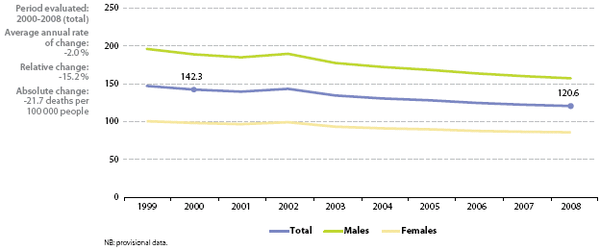
- Differences remain between lower and higher income Member States
During the period 2000 to 2002 death rates rose in several Member States, as is particularly evident from the small peak in 2002. One reason for this short-lived phenomenon could be the economic downturn at that time [2]. However, between 2000 and 2009, death rates due to chronic diseases have declined in almost all countries in the EU. Nevertheless in some lower-income Member States death rates due to chronic diseases remain high and still more than 150 people out of 100 000 people died from these diseases.
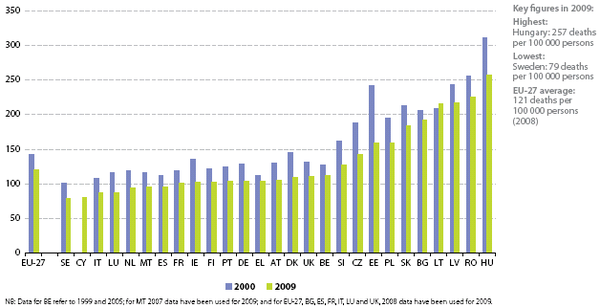
Suicides
Deaths through suicide in the EU declined substantially between 2000 and 2008. Progress is visible amongst the youngest and, most notably, oldest age groups
- Suicide is more common amongst men than women and amongst older age groups
Although cultural factors can influence the official rate of deaths by suicide, it may be considered an indicator of mental health. Overall, suicides in the EU declined by an annual average of 1.9 % between 2000 and 2008.
Suicide death rates vary between the sexes [3] and between age groups. Suicides are roughly three times more common amongst men than women in the young and middle-age group and five times more common in the oldest age group. However, the gap between men and women has been closing slowly.
- Economic crisis has had an impact on suicides among the working age group
Overall, since 2000 suicide rates fell in the young group aged 15-19 years by 1.9 % per year and in the oldest group aged over 85 years suicides by 3.6 % per year. On the other hand, there has been a slight increase in suicides of 0.1 % per year among people aged 50-54 years. This development has closed the gap between the older two age groups. However since 2006 the decrease in suicides of people over 85 years has slowed down while in the middle age group the increase in suicides has accelerated. The increase in the middle age group has been linked to the impact of the economic crisis on unemployment [4], which had already started to exert its negative effects in 2007 and 2008 [5].
]]
Unmet needs for healthcare
The share of people reporting that they could not afford a medical examination or treatment is higher in the lower income groups, which is indicative of inequalities in access to health care between income groups

The cost of medical treatment is an obstacle to the poorest people in some Member States
This indicator highlights the inequalities in access to medical care across income classes. Less than 1 % of the highest income group perceive themselves as unable to afford a medical examination or treatment when they need it. In general this is also the case at the Member State level. As income decreases the proportion of those who consider expense as an obstacle to seeking medical care increases. The extent of this gradient across income groups varies considerably by country. It is negligible in Denmark, Slovenia and the UK and rather high in Latvia, Portugal and Romania.
Although changes in the questionnaire between the annual surveys in some Member States prevent the evaluation of progress in this indicator over time, the gradient across income groups is consistent throughout the survey period.
Determinants of health
Production of toxic chemicals
There has been a moderately favourable decrease in the production of toxic chemicals between 2004 and 2007 in the EU-25

Production of toxic chemicals has decreased slightly since 2004 and there has been a shift towards less toxicity
Since 2004 the production of toxic chemicals in the EU-25 has slightly decreased, by 0.3 % per year on average. There has also been a favourable shift away from the production of the most toxic chemicals towards safer products. The share of toxic chemicals in the total production of chemicals in the EU-25 decreased by 2.1 percentage points between 2004 and 2007.
A longer term view is given by data for EU-15. From 1995 to 2000 production of total toxic chemicals in the EU-15 grew at an unfavourable rate of 3 % on average per year, with the strongest growth occurring in the most toxic classes. This trend has not yet reversed, but production remained relatively stable between 2000 and 2007, with a 0.2 % average annual growth rate over this period. This effect can partly be explained by the global economic downturn of 2001-2003 which resulted in a fall in production for all industrial areas, including chemicals.
In June 2007 a Regulation for the registration, evaluation, authorisation and restriction of chemicals (REACH) entered into force. The decrease since 2005 suggests that some companies may have already adapted their production in advance.
Exposure to air pollution by particulate matter
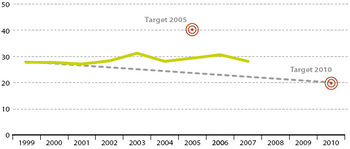
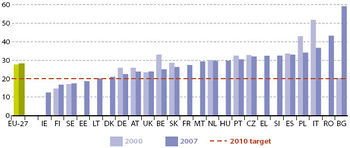
Exposure to air pollution by particulate matter has risen slightly in the EU-27 between 2000 and 2007 and there has been no progress towards the 2010 target
Exposure to airborne particulate matter has not decreased and there has been no progress towards the 2010 target
Between 2000 and 2007, air pollution by particulate matter rose in the EU-27 by 0.5 micrograms per cubic metre. While the 2005 target was easily met, reaching the 2010 target of 20 micrograms will require a yearly decrease of 2.7 micrograms from 2007 onwards.
The peaks in 2003 and 2006 were at least partially due to severe heat waves during those summers. The hot, dry conditions led to stagnant air in which pollutants accumulated. In 2003, at least, conditions were exacerbated by the prevalence of wildfires in south-western Europe producing large quantities of particulates which were then transported to the northern and eastern parts of Europe [6].
Urban exposure to particulates varies from country to country. Apart from sporadic wildfires, the Member States bordering the Mediterranean also suffer from dust blown from North Africa.
Exposure to air pollution by ozone
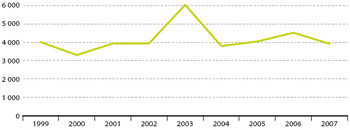
Exposure to ozone has increased in the EU-27 between 2000 and 2007 by 2.5 % per year on average, with considerable variation from one year to the next
Exposure to ozone has risen, with a peak in 2003
Although exposure to ozone varies considerably from year to year, overall it has risen at an annual average rate of 2.5 % since the year 2000. The high exposure in the year 2003 is related to the heat wave in that summer [7]. A lesser peak also occurred in 2006 for similar reasons.
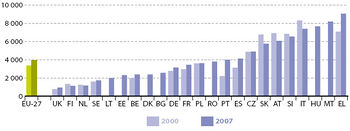
Urban exposure to ozone widely varied between countries, partly due to differences in climate and vegetation. In general, southern countries, with higher summer temperatures, such as Greece and Malta show higher exposure levels than the cooler northern countries such as the UK, Finland and the Netherlands. Nevertheless, peaks occurred throughout the EU in 2003 and 2006 due to exceptionally high temperatures in those years. This increase was most pronounced in the northern countries, which showed higher relative increases compared to the southern countries.
Annoyance by noise
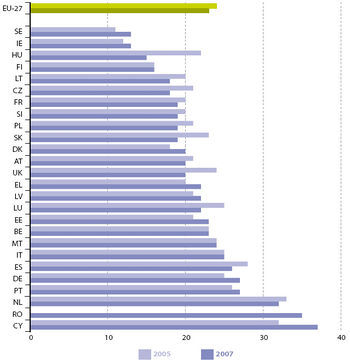
Over the short period from 2005 to 2007, the share of people in the EU-27 feeling annoyed by noise declined significantly
The share of population annoyed by noise has been favourably declining, particularly in some eastern Member States
Between 2005 and 2007, the percentage of the population who declared that they suffer from noise declined by 2.1 % per year on average. Possible explanations for this decline are closedowns of heavy industry, quieter cars resulting from EU legislation (11) , and the replacement of tramways by subways and buses. Although these most recent data cannot be compared directly to the earlier time-series for EU-15, this earlier series is indicative of a longer term trend in the reduction of noise annoyance.
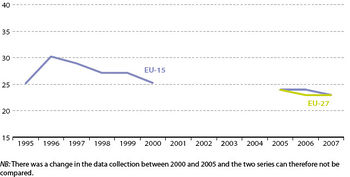
The country split shows that large reductions in noise annoyance have occurred in Hungary, the Czech Republic and Slovakia, and to a lesser extent in Lithuania, the UK and Luxembourg. On the other hand, in Cyprus, where the degree of annoyance was already high, Estonia, Germany, Greece and Sweden the situation worsened between 2005 and 2007.
Serious accidents at work
With the substantial decrease in serious accidents at work since 2000 across the EU-27 countries, the indicator presents a favourable development
Serious accidents at work are still at a high level but on track to meet the target for 2012
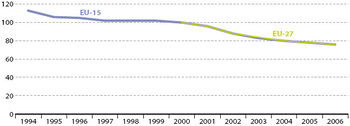
The incidence of serious accidents at work decreased in the EU-27 by 4.5 % per year on average between 2000 and 2006. This rate of decrease is close to the 5 % per year which will be needed in order to meet the target of an overall reduction of 25 % over the period 2007 to 2012.
This decline should be seen in light of the decline in heavy industry in the EU and the increasing use of automation. Despite this strong downward trend, serious accidents at work remain at a high level: in 2005 there were nearly 4 million serious accidents at work.
Further Eurostat information
Publications
- Health statistics - Atlas on mortality in the European Union Luxembourg, 2009
- Perception of health and access to health care in the EU-25 in 2007
- Sustainable development in the European Union - 2009 monitoring report of the EU sustainable development strategy
Database
- Indicators
- Public Health
Dedicated section
Other information
- Closing the gap in a generation: health equity through action on the social determinants of health, World Health Organization, Commission on Social Determinants of Health
- Major and chronic diseases - Report 2007 European Commission
- White paper - together for health: a strategic approach for the eU 2008-2013, European Commission
External links
See also
Notes
- ↑ Source:Table ‘Causes of death - Absolute number (Annual data) [hlth_cd_anr]’ on Eurostat website
- ↑ See the indicator ‘real GDP per capita’ in the ‘socioeconomic development’ chapter.
- ↑ Hawton, K., ‘Sex and suicide: Gender differences in suicidal behaviour’, British Journal of Psychiatry, Vol. 177, pp. 484-485
- ↑ Stuckler, D., Basu, S., Suhrcke, M., Coutts, A., and McKee, M., The public health effect of economic crises and alternative policy responses in Europe: an empirical analysis, The Lancet, Vol. 374, pp. 315-323, 2009
- ↑ European Commission Employment in Europe 2009, Luxembourg, Office for Official Publications of the European Union, 2009
- ↑ Hodzic A., Madronich, S., Bohn, B., Masiie, S., Menut, L., and Wiedinmyer, C., ‘Wildfire particulate matter in Europe during summer 2003: meso-scale modeling of smoke emissions, transport and radiative effects’, Atmospheric Chemistry and Physics, 2007, Vol. 7, pp. 4705-4760
- ↑ Johnson H., Kovats S., McGregor, G., Stedman, J., Gibbs, M., and Walton, H., ‘The impact of the 2003 heatwave on daily mortality in England and Wales and the use of rapid weekly mortality estimates’, Euro Surveillance, 2005, Vol. 10, pp. 168-171.







